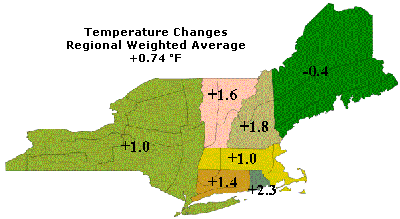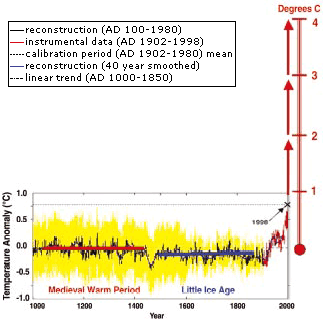 | ||||||||||||
 |
Estuarine ScienceGlobal Environmental Changes: Impacts
The weather and climate of New England has proven to be highly variable over long and short time scales and across short distances. Much of this variability can be attributed to the region's unique geographic location. In a given year, the region can experience hurricanes, blizzards, drought, and more. Over the past century, the historic record indicates that regional temperatures are warming especially in the coastal zone. Clearly, more warming has occurred during winter months. The limited data available indicate that regional snowfall and snowpack have decreased over the past 50 years (although this varies by state and climate zone). Ice-out dates (days in the spring when river ice has melted sufficiently to allow navigation) are occurring from four to six days earlier when compared with 100 years ago. There is limited evidence that extreme weather events may be on the rise, but a more thorough analysis is needed. How has the regional New England climate warmed over the past century?
In an analysis of the historic annual temperature and precipitation records, by region and by state, solid evidence exists that the climate has warmed over the past century (1895-1999). Overall, the region has warmed by 0.7 °F, yet Rhode Island has warmed 2.3 °F. Warming in winter months has been greater than summer-time warming. Regional precipitation has exhibited a modest (4%) increase over the same time period, but as with temperature, the change has not been uniform across the region. How and what are the scientists predicting about the next century? What will be the impact of a few degrees temperature increase? Are human activities affecting the climate?
How have past and present changes impacted the New England region? What is one of the more serious regional concerns about climate change? What would future warming trends impact? How will warming trends affect estuaries? As water warms it expands causing sea level to rise. Sea-level rise, which is already occurring, will become a significant problem for low-lying coastal regions (Cape Cod, coastal areas of CT, RI, MA, and NH), affecting both people and coastal wetlands. Currently, the average rate of sea-level rise on the Atlantic coast ranges from 3.5 inches per century in Boston, Massachusetts, to approximately a foot per century in coastal salt marshes in southern Massachusetts. Different rates of sea-level rise occur at different locations due to local rates of subsidence (settling) or uplift. With the retreat of glacial ice from the region 20,000 years ago, sea coasts began to rebound (or uplift) to a greater or lesser degree from the weight of the ice. The greater the amount of ice removed, the greater the degree of rebound. While portions of the Maine coast may still be rebounding, the coastal areas to the south now appear to be subsiding. About 33 acres of land are lost on Massachusetts' Cape Cod each year- 73% due to advancing seawater and 27% to erosion. A one degree change in ocean temperature would mean a one meter rise in sea level. The second reason for sea-level rise is the melting of glaciers and ice caps. Clear documentation exists of the recession of approximately 80% of mountain glaciers around the world. There is also limited documentation for a small reduction in the Greenland ice sheet (especially in the southern region). A last reason for sea-level rise is human activity. As we mine water from aquifers as a source of drinking water, the aquifers recharge more slowly than we empty them, and the mined water finds it's way into the ocean. We also drain wetlands, pumping the water into drainage systems or directly into the oceans. Such direct human activity may account for a third of sea level rise per year. One result of rising sea level is that the saltwater wedge, vital to the health of an estuary, would migrate upstream, causing a shift of marine ecosystems upriver unless freshwater runoff is increased. Sea-level rise will cause salt water to move into new areas. This is called saltwater intrusion and it could convert some areas of coastal freshwater wetlands to salt marshes. Groundwater could also be affected, as brackish water infiltrates aquifers that supply drinking water to coastal communities. Saltwater intrusion combined with low freshwater flow, could result in a higher chloride water content in important aquifer systems and water supplies. Low flow, a rise in sea level, or both could affect the water supplies in coastal regions. In addition, as sea level continues to rise, the amount of the region's coastal area subject to flooding from coastal storms will increase, especially in areas of low relief. Increases in sea level can cause dramatic changes, as higher sea levels would provide a raised base from which storm surges may sweep inland, allowing for greater and more widespread damage than would occur with lower sea levels. Even if storm strength were not increased, higher sea levels will result in more damage. How will the economy be impacted? The fishing industry will be affected. Scientists suggest that warmer late winter-early spring temperatures combined with continued sea-level rise could have a significant impact for commercial fishing. The greatest portion of U.S. commercial fishery catches (except Alaska) are estuarine dependent, with 32% of the fisheries of Cape Cod and north estuarine dependent. Coastal wetlands, estuaries, and other intertidal areas such as mud flats are important nursery grounds for many species of commercial fish and shellfish and important feeding grounds for many migrating waterfowl. Because these ecosystems often are adapted to specific temperature, salinity, and tidal conditions, commercial species and whole ecosystems could be lost if the upstream conditions are not suitable for migration or the species are unable to migrate in response to changing sea level. A sea-level rise that is rapid enough to damage coastal wetlands would cause a significant decline in coastal fisheries. Shoreline construction which prevents erosion or submergence or is otherwise unsuitable would prevent estuarine and intertidal habitat shifts that might have occurred due to sea-level rise. Preserving estuarine and intertidal habitats will become more of a significant concern, as the future climate changes. The winter flounder case study conducted by the US Global Change Research Program addresses the issue of current climate change impacts on abundance of this commercially important marine species. The winter flounder may well be an indicator species sensitive to increases in water temperatures. Warmer water temperatures appear to have set off a chain of circumstances that began with the loss of the winter flounder population and resulted in increased populations of warmer water invertebrates and migrant fishes. Another industry sure to be affected is the insurance industry. Evidence of increases in extreme weather events is provided in the form of increasing trends in weather-related insurance claims. Complicating the increase in severe storms is the fact that human population in the US is increasing, and more people are building more expensive homes in weather-sensitive areas (coastal property susceptible to hurricanes, and floodplains vulnerable to flooding).
|
|||||||||||

